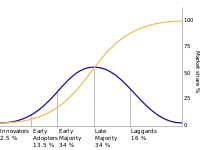
Photo from wikipedia
ABSTRACT Numerous theoretical and empirical studies provide evidence of a positive correlation between eco-innovation and environmental regulation. However, few analyses explain how environmental policies drive eco-innovation. This article studies eco-innovation-friendly… Click to show full abstract
ABSTRACT Numerous theoretical and empirical studies provide evidence of a positive correlation between eco-innovation and environmental regulation. However, few analyses explain how environmental policies drive eco-innovation. This article studies eco-innovation-friendly mechanisms in the design of European REACH (Registration, Evaluation, Authorization of Chemicals) regulation. The aim of REACH, which became effective in 2007, is ‘to ensure a high level of protection of human health and the environment while improving competitiveness and innovation’ which makes it appropriate and original for analysing the relationship between environmental regulation and eco-innovation. The primary contribution of this article is to provide a new theoretical and empirical perspective on eco-innovation by showing how design regulation is able to push and pull the environment innovation, based on an original survey related to REACH regulation. The econometric model shows that (1) regulatory-push mechanisms seem to be more important drivers than regulatory-pull mechanisms; (2) the process of authorization and the obligation to transmit information throughout the supply chain play an important role in ‘pushing’ eco-innovation, suggesting that policymakers should promote new ‘green knowledge’ to encourage eco-innovation; (3) extending obligations has a significantly positive effect on ‘pulling’ eco-innovation and (4) only well-designed instruments, appropriate for the techno-industrial and institutional contexts in which they are to be applied, lead to innovation.
Journal Title: Applied Economics
Year Published: 2018
Link to full text (if available)
Share on Social Media: Sign Up to like & get
recommendations!